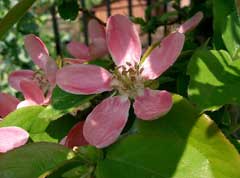 |
|
http://commons.wikimedia.org/wiki/User:KENPEI |
 |
| http://commons.wikimedia.org/wiki/User:Dalgial |
Translate this page:
Summary
Bloom Color: Pink. Main Bloom Time: Early spring, Late spring, Mid spring. Form: Vase.
Physical Characteristics

 Pseudocydonia sinensis is a deciduous Tree growing to 6 m (19ft) by 6 m (19ft) at a slow rate.
Pseudocydonia sinensis is a deciduous Tree growing to 6 m (19ft) by 6 m (19ft) at a slow rate.
See above for USDA hardiness. It is hardy to UK zone 6. It is in flower from April to May, and the seeds ripen in October. The species is hermaphrodite (has both male and female organs) and is pollinated by Insects.
Suitable for: light (sandy), medium (loamy) and heavy (clay) soils. Suitable pH: mildly acid, neutral and basic (mildly alkaline) soils. It cannot grow in the shade. It prefers moist soil.
UK Hardiness Map
US Hardiness Map
Synonyms
Chaenomeles sinensis. Cydonia sinensis. Malus sinensis.
Plant Habitats
Woodland Garden Sunny Edge;
Edible Uses
Edible Parts: Fruit
Edible Uses:
Fruit - eaten as a sweetmeat, candied, preserved in syrup or made into a liqueur[46, 183]. The juice can also be mixed with ginger and made into a beverage[183]. The fruit is very large, up to 18cm long[105, 179].
References More on Edible Uses
Medicinal Uses
Plants For A Future can not take any responsibility for any adverse effects from the use of plants. Always seek advice from a professional before using a plant medicinally.
Antitussive
The fruit is antitussive[174, 279]. It contains several medically active constituents including organic acids plus the flavonoids rutin and quercetin[279]. It is used in Korea to treat asthma, the common cold, sore throats, mastitis and tuberculosis[279].
References More on Medicinal Uses
The Bookshop: Edible Plant Books
Our Latest books on Perennial Plants For Food Forests and Permaculture Gardens in paperback or digital formats.

Edible Tropical Plants
Food Forest Plants for Hotter Conditions: 250+ Plants For Tropical Food Forests & Permaculture Gardens.
More

Edible Temperate Plants
Plants for Your Food Forest: 500 Plants for Temperate Food Forests & Permaculture Gardens.
More

More Books
PFAF have eight books available in paperback and digital formats. Browse the shop for more information.
Shop Now
Other Uses
Pot-pourri Wood
The fruits are very aromatic and are placed in a bowl to impart a delightful spicy scent to a room[46]. Wood - hard, dark red. Used for picture frames[174].
Special Uses
References More on Other Uses
Cultivation details
Landscape Uses:Specimen. Requires a sunny position[1, 11], succeeding in any reasonably good soil that is well-drained but not dry[1, 200]. Trees are very hardy when grown in a continental climate with long hot summers but in the cooler climate of Britain where they do not always ripen their wood they are only reliably hardy to about -5°c[200]. They grow well on a south-facing wall[11, 200] and this is the only way to ensure that they fruit well in Britain[1]. A plant growing in a sunny position on the south side of tree cover at Kew was 3.5 metres tall in spring 1995 and looked healthy[K]. Occasionally cultivated, especially in China[46], for its edible fruit, there are some named varieties[183]. There is a disagreement over the correct name for this species, with some authorities using Pseudocydonia sinensis[11, 200] and others Chaenomeles sinensis[266]. Flowers are produced on year-old wood[200]. Special Features:
Not North American native, Fragrant flowers, Attractive flowers or blooms.
References Carbon Farming Information and Carbon Sequestration Information
Temperature Converter
Type a value in the Celsius field to convert the value to Fahrenheit:
Fahrenheit:
The PFAF Bookshop
Plants For A Future have a number of books available in paperback and digital form. Book titles include Edible Plants, Edible Perennials, Edible Trees,Edible Shrubs, Woodland Gardening, and Temperate Food Forest Plants. Our new book is Food Forest Plants For Hotter Conditions (Tropical and Sub-Tropical).
Shop Now
Plant Propagation
Seed - best sown in a cold frame as soon as it is ripe in the autumn[200]. Stored seed requires 3 months cold stratification and should be sown as early in the year as possible[113]. When they are large enough to handle, prick the seedlings out into individual pots and grow them on in the greenhouse for at least their first winter. Plant them out into their permanent positions in late spring or early summer, after the last expected frosts. Layering.
Other Names
If available other names are mentioned here
Native Range
TEMPERATE ASIA: China (Anhui Sheng, Fujian Sheng, Guangdong Sheng, Guangxi Zhuangzu Zizhiqu, Guizhou Sheng, Hebei Sheng, Hubei Sheng, Jiangsu Sheng, Jiangxi Sheng, Shaanxi Sheng, Shandong Sheng, Zhejiang Sheng)
Weed Potential
Right plant wrong place. We are currently updating this section.
Please note that a plant may be invasive in one area but may not in your area so it's worth checking.
Conservation Status
IUCN Red List of Threatened Plants Status :

Growth: S = slow M = medium F = fast. Soil: L = light (sandy) M = medium H = heavy (clay). pH: A = acid N = neutral B = basic (alkaline). Shade: F = full shade S = semi-shade N = no shade. Moisture: D = dry M = Moist We = wet Wa = water.
Now available:
Food Forest Plants for Mediterranean Conditions
350+ Perennial Plants For Mediterranean and Drier Food Forests and Permaculture Gardens.
[Paperback and eBook]
This is the third in Plants For A Future's series of plant guides for food forests tailored to
specific climate zones. Following volumes on temperate and tropical ecosystems, this book focuses
on species suited to Mediterranean conditions—regions with hot, dry summers and cool, wet winters,
often facing the added challenge of climate change.
Read More
Expert comment
Author
(Dum.Cours.)C.K.Schneid.
Botanical References
11200266
Links / References
For a list of references used on this page please go here
Readers comment